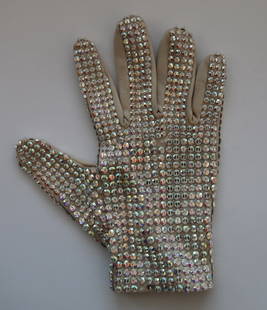The iconic Michael Jackson, often revered as the King of Pop, continues to capture the imagination of fans and collectors alike, even years after his untimely passing. Recently, an extraordinary piece of memorabilia associated with the artist—a stage-used Swarovski glove—took center stage at an auction, commanding a staggering $190,000. This remarkable event not only stirred excitement among avid collectors but also reignited discussions surrounding the cultural significance of Jackson’s memorabilia.
The glove, a mesmerizing assemblage of crystals and meticulous craftsmanship, served as a vital element of Jackson’s performance wardrobe. First donned during a period when his artistic genius reached unprecedented heights, the glove is emblematic of Jackson’s unique style and his role in pioneering the music video format. It encapsulates a fusion of pop culture and artistry that transcends generations.
During the auction, participants were treated to an exquisite visual display, showcasing not just the glove, but a plethora of memorabilia associated with luminaries from the entertainment industry. The bidding process was exhilarating, characterized by a palpable tension as fans and collectors vied for ownership of this extraordinary item. Ultimately, the glove’s sale price illustrates not only its monetary value but its profound emotional resonance with those who idolize the late artist.
What makes the Michael Jackson glove so special? For one, it represents an era defined by groundbreaking performances and cultural shifts. Jackson’s innovative dance moves, coupled with the enigmatic allure of his costumes, created a lasting impact on the music landscape. Collectors recognize the glove as a symbol of a transformative moment in pop culture—a relic of the 1980s that continues to inspire artists and fans globally.
The auction itself highlighted the increasing interest in celebrity memorabilia, particularly items with unique provenance. Collectors today are discerning; they seek authenticity, rarity, and historical significance. The sale of Jackson’s glove not only speaks to the financial investment in such artifacts but also reflects a broader obsession with the memorabilia that connects fans to their idols.
Moreover, the event served as a reminder of the ever-evolving nature of fandom. In the age of social media, the nostalgia surrounding iconic figures is amplified, making collectibles like the Swarovski glove even more coveted. The intersection of current technology and vintage nostalgia fosters a unique environment that keeps the memory of legends alive.
In conclusion, the impressive auction sale of Michael Jackson’s stage-used Swarovski glove represents much more than a financial transaction. It is a testament to the enduring legacy of a musical innovator. Collectors, fans, and new audiences alike can revel in the rich tapestry of artistic history encapsulated within such artifacts, perhaps inspiring the next generation of musicians and performers to embrace the creativity and innovation for which Jackson was known.
